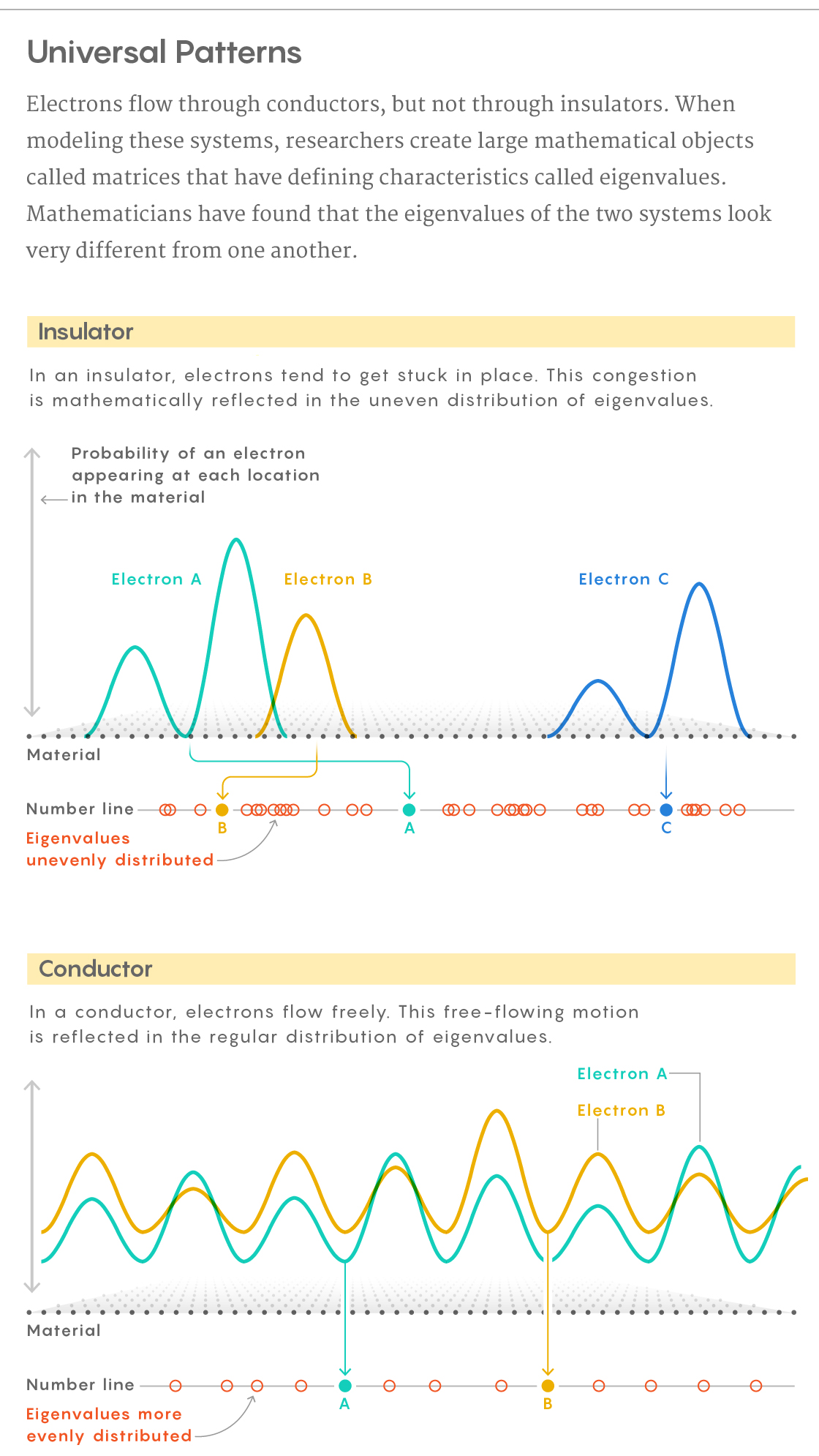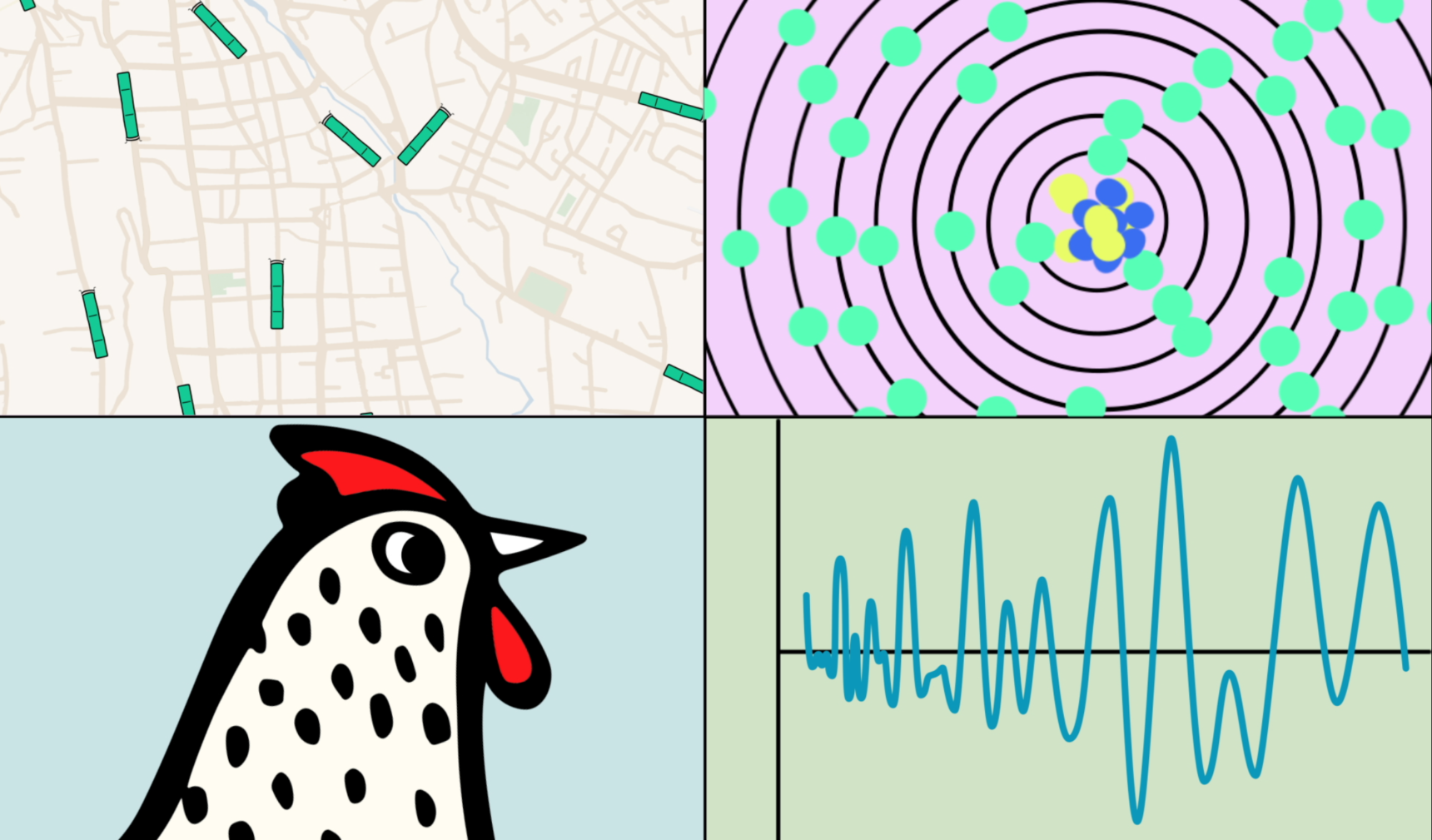Universal Pattern Explains Why Materials Conduct

The movement of electrons inside a conductor is impossible to calculate exactly.
Introduction
In a wire, electrons rebound off each other in such a complicated fashion that there’s no way to follow exactly what’s happening.
But over the last 50 years, mathematicians and physicists have begun to grasp that this blizzard of movement settles into elegant statistical patterns. Electron movement takes one statistical shape in a conductor and a different statistical shape in an insulator.
That, at least, has been the hunch. Over the last half-century mathematicians have been searching for mathematical models that bear it out. They’ve been trying to prove that this beautiful statistical picture really does hold absolutely.
And in a paper posted online last summer, a trio of mathematicians have come the closest yet to doing so. In that work, Paul Bourgade of New York University, Horng-Tzer Yau of Harvard University, and Jun Yin of the University of California, Los Angeles, prove the existence of a mathematical signature called “universality” that certifies that a material conducts electricity.
“What they show, which I think is a breakthrough mathematically … is that first you have conduction, and second [you have] universality,” said Tom Spencer, a mathematician at the Institute for Advanced Study in Princeton, New Jersey.
The paper is the latest validation of a grand vision for quantum physics set forward in the 1960s by the famed physicist Eugene Wigner. Wigner understood that quantum interactions are too complicated to be described exactly, but he hoped the essence of those interactions would emerge in broad statistical strokes.
This new work establishes that, to an extent that might have surprised even Wigner, his hope was well-founded.
Universally Strange
Even seemingly isolated and unrelated events can fall into a predictable statistical pattern. Take the act of murder, for example. The stew of circumstances and emotions that combine to lead one person to kill another is unique to each crime. And yet someone observing crime statistics in the heat of an urban summer can predict with a high degree of accuracy when the next body will fall.
There are many different types of statistical patterns that independent events can follow. The most famous statistical pattern of all is the normal distribution, which takes the shape of a bell curve and describes the statistical distribution of a wide range of uncorrelated events (like heights in a population or scores on the SAT). There’s also Zipf’s law, which describes the relative sizes of the largest numbers in a data set, and Benford’s law, which characterizes the distribution of first digits in the numbers in a data set.
In the 1950s, Wigner confronted a problem and needed the help of a new statistical pattern to solve it. More than a decade after he’d helped instigate the Manhattan Project, he wanted to model interactions between the hundreds of particles inside the uranium nucleus. The problem was too complicated to tackle directly.
“A large nucleus is a complicated thing; we have no idea how to understand it from first principles,” Spencer said.
So Wigner simplified the problem: He ignored individual particle interactions, which were too hard to map, and instead focused on the average statistical behavior of the whole system, which was more tractable.
Wigner implemented this picture using a grid of numbers that specify how particles interact. This grid is known as a matrix. It’s like a technical appendix for the Schrödinger equation, which is the equation used to describe the behavior of subatomic particles. By specifying the numbers in the matrix exactly, you specify the interactions exactly.
Wigner couldn’t do that, so instead he filled the matrix with random numbers. He hoped this simplification would enable him to proceed with his calculations, while still producing a useful description of the uranium nucleus at the end.

5W Infographics for Quanta Magazine
Which it did. Wigner found that he was able to extract a pattern from his “random” matrix. The pattern involved a second layer of numbers called eigenvalues, which are like the DNA of a matrix. Puzzlingly, his random matrix had correlated eigenvalues. On a number line, the eigenvalues seemed to exhibit a somewhat regular spacing — never clustered together nor spread too far apart. It was almost as if they were magnets, pushing each other toward an even spacing. The resulting distribution is now often referred to as the Wigner-Dyson-Mehta distribution (after the three physicists who contributed to its discovery). It describes a phenomenon called universality.
To get a sense of universality, consider how tall people are. In the real world, if you started plucking people two at a time from a crowd in Times Square, there’s a reasonable chance that you’d find pairs of people with approximately the same height. But if heights in a population followed the Wigner-Dyson-Mehta distribution, you wouldn’t expect two randomly selected people to have similar heights at all. The heights would be correlated in such a way that the first person’s height was always different from the second person’s.
Universality describes many different kinds of things: the frequency and size of avalanches, the timing of buses in decentralized transit systems, and even the spacing of cells in the retina of a chicken. It pertains, in general, to complex, correlated systems.
Wigner’s experience modeling the uranium nucleus led him to hypothesize that random matrices should be able to describe any quantum system in which particles are correlated with one another (meaning that all particles influence the others). “Wigner’s great vision was, he believed that you can take any quantum system, and if it’s highly correlated, then its [eigenvalue distribution] will be similar to random matrices,” Yau said.
(Later researchers articulated the flip side of the picture: They conjectured that when the particles in the physical system are moving in an uncorrelated way, as they do in an insulator, the eigenvalues should fall into the “Poisson” distribution, which is related to the normal distribution.)
When materials conduct, it’s precisely because their electrons are interacting in an orderly correlated way — moving together as if in lockstep, carrying the electrical current along. So Wigner’s conjecture showed that if the eigenvalues of a quantum system exhibited universality, it would be proof that the particles within the system were interacting in a correlated way, and thus that the system was a conductor.
Mathematicians and physicists began to fill in the details of his vision almost immediately, but it would take a half-century for mathematicians to start to prove facts about the statistics of conductors in real-world settings.
Broken Simplicity
When mathematicians create models of physical systems, they’d like those models to be as realistic as possible. Wigner’s model of the uranium nucleus was not a very realistic one for conductors in one sense: It included the assumption that every particle was equally likely to interact with every other particle. The model made no allowance for the fact that in a material, particles that are closer together are more likely to interact than particles that are farther apart. “Because particles in his system are all tightly confined to this small area called a nucleus, every guy interacts with every other guy, and Wigner did not take into account any spatial structure,” Spencer said.
Physical models that don’t take into account the distance between particles are called “mean field” models. They’re simpler to work with, but more tenuously connected to the physical world.
“There are no geometry considerations; we make the huge simplification that all the atoms in your medium interact with everyone in the same way,” Bourgade said.
In two papers published a decade ago, mathematicians proved that eigenvalues for conducting materials follow Wigner’s universal pattern — but the proof only applied to the mean field model. That left open the more physically relevant case of proving universal eigenvalues arise in non-mean-field models, in which particles are only allowed to interact with particles right around them.
This new paper gets almost all the way there. The three authors work with models in which particles interact with more particles than just their immediate neighbors, but not with all the particles in the system. The matrices describing such interactions are called random-band matrices (with “band” referring to the zone around each particle in which interactions occur). “The band matrix has a certain structure where you only talk to your neighbors and interactions aren’t very far away,” Yau said.
The authors proved that eigenvalues in certain random-band matrices — those where the band is a certain minimum width — still follow the distribution Wigner observed in mean-field matrices. This means that even when you restrict electrons to interacting only with other particles in their neighborhood, the entire physical system still maintains the same type of average statistical behavior — the distribution of its eigenvalues — that Wigner found in his more stripped-down framework.
“We proved that for the random-band-matrix model, the eigenvalues repulse each other … which means conduction,” Bourgade said. Bourgade, Yin and Yau would like to extend this work to the full non-mean-field case, cinching the relationship between conduction and its mathematical representation. It’s a tight alignment that might have seemed improbable when Wigner first discovered universally distributed eigenvalues. Now it’s starting to feel inevitable.
“I am still amazed that Wigner’s vision is correct,” Bourgade wrote in an email.




